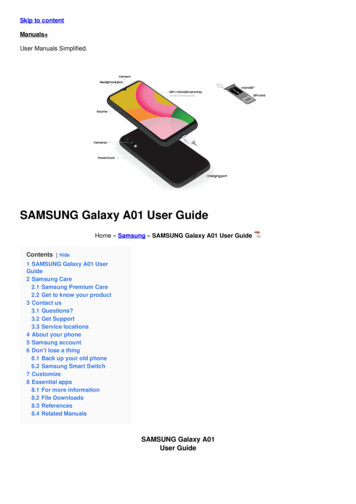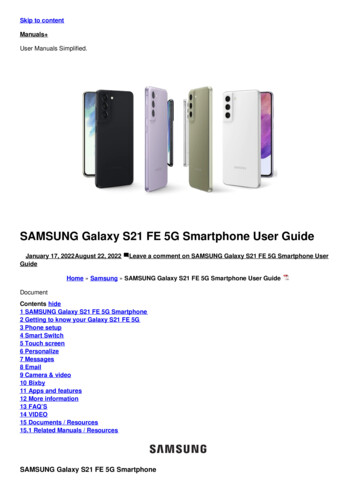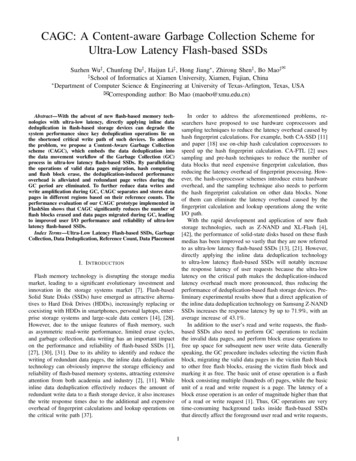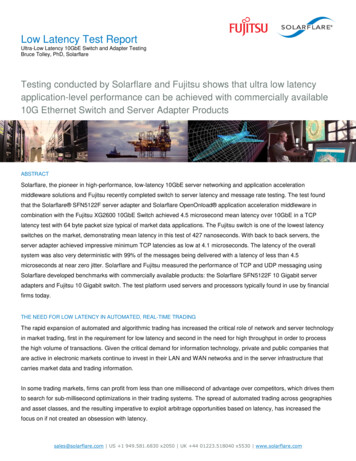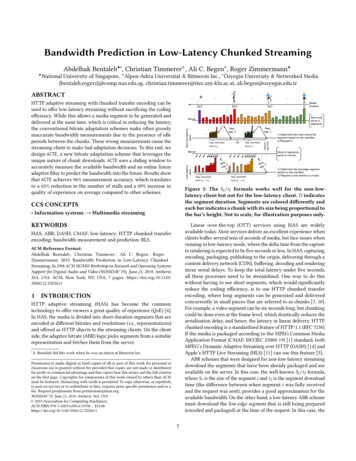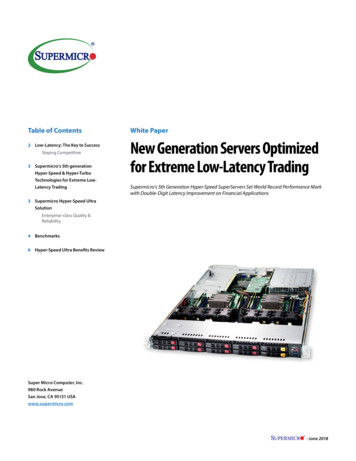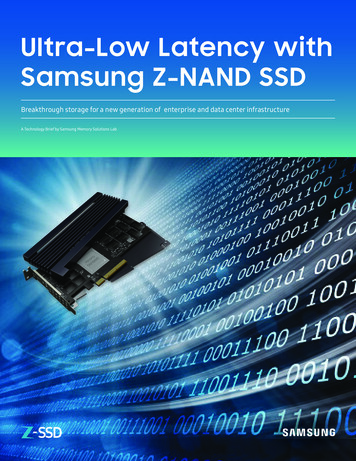
Transcription
Ultra-Low Latency withSamsung Z-NAND SSDBreakthrough storage for a new generation of enterprise and data center infrastructureA Technology Brief by Samsung Memory Solutions Lab
Samsung Z-NAND SSD Technology BriefUltra-Low Latency with Samsung Z-NAND SSDIntroductionThe rapid adoption of flash in the data center and the enterprisehas contributed to significant improvements in the storageinfrastructure and the applications that run on top of it.Meanwhile, rapidly growing demand has driven all suppliers tooffer comparable flash storage devices. While IOPS, capacity andbandwidth remain important storage criteria, the latency in flashdevices can become a significant bottleneck hampering systemoptimization. To address the performance gaps resulting fromunacceptably low latency, Samsung has developed a disruptivenew tier of NAND technology called Z-NAND , which is set togive enterprise architects new highly-efficient storage optionsTMfor their data-intensive workloads. It is expected to be in demandalmost overnight in a wide range of industries, for use casessuch as high capacity caching, NoSQL databases, data stores andbusiness analytics.Z-SSD: Samsung Z-NAND SSDSamsung SZ985 Z-NAND SSDThe first storage device based on Samsung’s Z-NAND technologyis the SZ985 — an “ultra-low latency” flash storage drive. TheSamsung SZ985 Z-NAND SSD shares the fundamental structure ofSamsung’s V-NAND — the industry’s leading 3D flash productiontechnology. It offers a unique circuit design and controller, whichtogether serve to maximize performance. The SZ985 provides 5.5Form FactorHHHLInterfacePCIe Gen3 x4NANDZ-NAND TechnologyPortSingleData Transfer Rate (128KB data size)times lower latency than today’s leading NVMe SSDs. Availablein an 800GB capacity, the drive has been designed with provenSequential Read /Write (GB/s)NAND technology for improved reliability, exceptional scalabilityand greater cost-efficiency. This pioneering generation of Z-SSD’s3.2 / 3.2Data I/O Speed (4KB data Size, sustained)can easily be considered the optimal storage solution for latency-Random Read / Write (IOPs)sensitive, I/O-intensive applications.750K/ 170KLatency (sustained random workload)[2]Random Read12 - 20µsRandom Write (Typical)16µsDWPD30Capacity800GB
Samsung Z-NAND SSD Technology BriefUnprecedented Storage Performance forData-Intensive WorkloadsLatency, speed, scalability, capacity and attractive pricing allRocksDB Throughputfactor into the viability of the SZ985 for big data applications.A comparison of application-specific benchmarks for massivePM1725aZ-SSDdata workloads clearly demonstrates the superiority of the140000O P E R AT I O N S P E R - S E CO N Dwhen running mission-critical applications. Moreover, the SZ985is a feature-rich storage solution that can be applied to a hostof data-intensive applications right out of the box. As the I/Ostorage stack continues to improve, applications can expectto gain substantial additional performance when deployingSamsung Z-NAND SSD.Application performance is characterized by an increase inthroughput, a decrease in latency or both concurrently. Our12000010000080000BIGGER IS BETTERSamsung Z-NAND SSD over the highest-performing NVMe SSD,2x600004000020000performance testing demonstrates that the raw latencyspeed-ups of the Z-SSD device are passed on to the application0level, delivering tangible user-level performance accelerationRocks DBin a diverse set of use-cases.Impact of RocksDBRocksDB Average LatencyRocksDB is a popular “key value” store that serves as a backPM1725aMySQL, etc.) and is prevalent in many data center productionsstacks. Our RocksDB performance benchmarking illustratesa large increase in throughput as a result of the decrease inZ-SSD device latency. A deployment of Samsung SZ985 Z-NANDSSD compared to that of the popular PM1725a NVMe SSDdemonstrates that databases can expect to see theirthroughput double and their latency cut in half.Z-SSD3503002502001/2 x150100500Rocks DB[3]SMALLER IS BETTERR O C K S D B AV E R A G E L AT E N C Y ( µ S E C )end to other applications and databases (e.g. MongoDB, Redis,
Samsung Z-NAND SSD Technology BriefUnprecedented Storage Performance forData-Intensive Workloads (continued)CachingCachingAnother important application is caching. Memcached is aNUMBER OF GETS-PER-SECONDspeed up database-driven websites by caching data in RAM toreduce the number of times the database must be accessed.Fatcache extends the Memcached system to advanced SSDs,to provide a much larger caching capacity. Our tests usingfatcache show a 1.6x throughput increase with Z-SSD comparedto the PM1725a, reaffirming that Z-SSD is well-suited forcaching purposes.Operating System PagingPaging performance can also be critical. Page swappinghappens when the accumulated working set size exceeds theZ-SSD5000004500004000003000001.6 xBIGGER IS BETTERdistributed memory caching system. It is typically used acity of the server’s physical memory. Due to the dynamicnature of data center workloads, swapping cannot be completelyavoided. However, given the large latency gap between memoryand storage, OS paging can be detrimental to application performance and to the user experience. We evaluated OS paging performancewith Z-SSD using Memcached as a test case. Our results show that Z-SSD is a superior choice as a swap space target — it provides 3x theperformance at a third of the latency, compared to the PM1725a, thus successfully mitigating user-level performance 000R E A D L AT E N C Y ( µ S E C 3 x600400SMALLER IS BETTER90000BIGGER IS BETTERM E M C AC H E T H R O U G H P U T (O P/ S E C )Throughput20000MemcachedMemcachedTo summarize, these three test examples demonstrate Z-NAND SSD’s high degree of effectiveness in increasing throughput and loweringlatency, across diverse domains. They show that the exceptional device-level performance of Z-NAND carries through to the applicationlevel, delivering an overall user-level performance increase and simplifying integration of the storage device in virtually any application.[4]
Samsung Z-NAND SSD Technology BriefConclusionAbout Samsung Electronics Co., Ltd.New benchmark testing shows conclusively that the SZ985Z-NAND SSD enables a new tier of storage with the highestSamsung Electronics Co., Ltd. inspires the world and shapes thethroughput and lowest latency of any flash storage on the marketfuture with transformative ideas and technologies. The companytoday. This gives enterprise architects a compelling reason tois redefining the worlds of TVs, smartphones, wearable devices,consider Z-NAND when optimizing current and future workloads.tablets, cameras, digital appliances, printers, medical equipment,The SZ985 combines extreme performance, durability, low latencynetwork systems, and semiconductor and LED solutions.and high capacity into a single, ready-to-install storage devicesuitable for most data centers today.For the latest news, please visit the Samsung Newsroom atnews.samsung.com.For more information contact Samsung at:msl-inquiry@ssi.samsung.com.Copyright 2017 Samsung Electronics, Co. Ltd. All Rights Reserved. All brand, product, service names and logos are trademarks and/or registered trademarks of their respectiveowners and are hereby recognized and acknowledged. Specifications and designs are subject to change without notice. All data were deemed correct at time of creation.Samsung is not liable for errors or omissions. PID 2017-07[5]
Breakthrough storage for a new generation of enterprise and data center infrastructure Ultra-Low Latency with Samsung Z-NAND SSD [ 2 ] Samsung Z-NAND SSD Technology Brief . Specifications and designs are subject to change without notice. All data were deemed correct at time of creation. Samsung is not liable for errors or omissions. PID 2017-07


